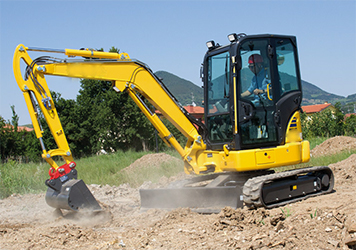Infrastructure wave of ‘small machinery big demand’ Southeast Asia is experiencing an unprecedented infrastructure expansion cycle. Indonesia to move the capital of East Kalimantan, the Philippines ‘big building special construction’ plan, Thailand’s Eastern Economic Corridor, Vietnam North-South High Speed Railway and other mega-projects one after another, only the first half of 2023, Southeast Asia’s total national infrastructure investment of more than 80 billion U.S. dollars. Unlike large-scale engineering equipment, small excavators with flexible and mobile, adapt to the characteristics of the narrow operating surface, become a river dredging, pipeline network laying, rural road and bridge construction and other ‘capillary’ project protagonist. In Indonesia, Jakarta Bay Area renovation project, for example, the cumulative investment of more than 500 sets of small excavators, is reshaping the ‘Venice of the Sea’ of the underground pipe network system. China’s Smart Manufacturing Knocks on the Door of Opportunity The spurt of growth in exports stems from the ability of Chinese brands to accurately grasp market demand. Sany Heavy Industry’s corrosion-resistant models developed for the hot and humid climate of Southeast Asia, XCMG’s high-climbing models adapted to tropical rainforest conditions, and LiuGong’s new-generation products equipped with intelligent control systems constitute a differentiated competitive matrix. What’s more, relying on the complete supply chain system in China, Chinese enterprises can control the unit price at about 70% of the international brands, while maintaining the autonomy of the core components of more than 85%, a combination of ‘cost-effective + technology self-reliance’, successfully breaking the situation of Japan, South Korea’s long-term dominance of the brand. From product export to ecological deep ploughing The growth of export volume is just a prelude to a deeper change that is taking place. Zoomlion has established a spare parts centre in Malaysia to shorten the supply cycle to 48 hours; Ward Heavy Industries and Indonesian construction contractors jointly developed customized attachments to increase the utilization rate of equipment by 30%; and some enterprises have innovated the packaged service model of ‘equipment+operator+maintenance’, which has won a good reputation in the Philippines’ agricultural mechanization projects. This transformation from simply selling products to a solution provider, so that Chinese brands in Southeast Asia’s market penetration rate increased by 12 percentage points in six months. Global revelations during the window period Two features of the current Southeast Asian infrastructure market are worth paying attention to: first, the zero-tariff policy under the RCEP framework is accelerating the flow of equipment, and second, the carbon-neutral targets of various countries are driving a surge in the demand for electrified mini-excavators. Data show that Singapore has required all municipal projects after 2025 to adopt new energy equipment, which provides a clear direction for Chinese manufacturers to layout lithium drive products. At the same time, the exchange rate fluctuations of the Vietnamese dong and Indonesian rupee relative to the renminbi have forced enterprises to optimise cross-border financial services, and some of the headline enterprises have reduced their exchange losses to less than 0.3% through hedging. Standing in the global industrial transfer of the historical coordinate system to observe, Southeast Asia infrastructure tide precisely and China’s equipment manufacturing industry upgrading to form a resonance. When ‘Made in China’ meets ‘ASEAN opportunities’, the small excavator set off by the wave of exports, perhaps China’s smart manufacturing to the high-end of the value chain of the new starting point. In the next five years, as the ASEAN Connectivity Master Plan 2025 enters the peak of implementation, those who can integrate technological innovation, localised operations and green concepts will define the competitive pattern of the next trillion-dollar market.

A Russian customer placed an order for the SD17E at an exhibition.
A Russian customer placed an order for the SD17E at an exhibition.



